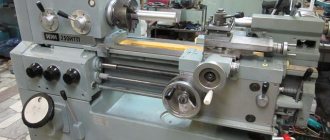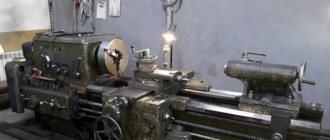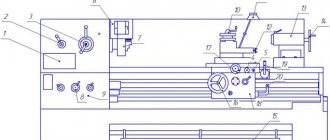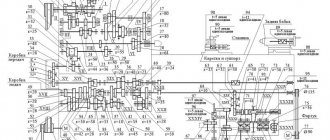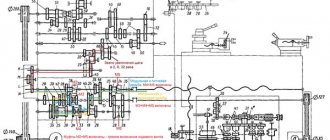The use of this type of equipment allows enterprises or repair shops, including those within large factories, to perform several metal processing operations. The decision to buy a screw-cutting lathe from the variety presented on our website will allow you to:
- reaming holes;
- grind and bore shaped, cylindrical and conical surfaces;
- perform countersinking;
- trim and process ends;
- drill holes;
- cut internal and external threads, including conical ones.
Main structural elements
The schematic diagrams of a screw-cutting lathe do not differ significantly from each other. Almost all models included in this group can be used for the following operations:
- Reaming holes.
- Performing operations for turning and boring surfaces. A screw-cutting lathe has a device that allows you to change both the outer and inner cylindrical surface. In this case, the body of revolution can be conical or shaped.
- When considering screw-cutting lathes and their purpose, attention should be paid to the possibility of trimming and processing end surfaces.
- When installing the appropriate equipment and cutting tools, you can perform operations related to drilling and countersinking.
- Many screw-cutting lathes have technical characteristics that allow them to cut threads on a wide variety of surfaces.
Main components of a screw-cutting lathe
A screw-cutting lathe may have a description indicating what tasks this equipment can be installed to solve. Despite belonging to the same group, screw-cutting lathes for metal can have different designs. Almost all models have the following structural elements:
- Front and rear headstocks, which house the main systems: gearbox, feed and power supply.
- A support intended for fastening a cutting tool.
- The parts of a screw-cutting lathe form a rotation transmission system from an electric motor, which is called a gearbox.
- Spindle. The kinematic diagram of a screw-cutting lathe transmits rotation to the spindle in which the workpiece is mounted.
- Bearing frame. In order for all units to be accurately positioned relative to each other, they are mounted rigidly or movably on the frame. This structural element is also intended to dampen vibration and other loads.
- The screw-cutting lathe has a scope of application in the field of thread cutting and provides for the presence of replaceable guitar gears. By selecting replacement wheels, the most suitable cutting mode is configured.
- Electrical unit for controlling equipment.
- Apron. This design allows you to protect the cutting zone and prevent scattering of chips and coolant. In addition, the apron can have additional equipment.
When considering the main components of a screw-cutting lathe, it should be taken into account that it is distinguished by the presence of a lead screw, as well as the possibility of carrying out a thread cutting operation.
Models of screw-cutting lathes can be designed for a wide variety of technological processes, but often have a similar layout. The difference lies in the build quality and the size of the main power units.
General information about screw-cutting lathes
Almost all machines identified in this group have the same structure and operating principle. They perform milling operations on workpieces made of ferrous and non-ferrous metals (including cast iron) and plastics. Specific technological capabilities are determined by the layout and accuracy class of the equipment, design features (modifications of machines), and the presence or absence of a numerical control (CNC) system.
Despite various modifications and different equipment manufacturers in Russia and abroad, the operating principle of such machines remains practically unchanged. The fixed part rotates around the longitudinal axis, a cutting tool is brought to it, with which part of the material is removed and the surface is formed. The main difference from conventional lathes is that on this equipment it is possible to cut threads along the outer diameter of workpieces.
Typical control unit
When considering a modern universal screw-cutting lathe, you should pay attention to the control unit. To indicate the main processing parameters, levers and handles, buttons and other control units are installed. The main features include the following points:
- As a rule, a handle is installed to indicate the number of revolutions. A universal modern screw-cutting lathe can change this indicator, which is selected depending on the required cutting conditions.
- A screw-cutting lathe has a device that allows the formation of a threaded surface. Its parameters are set using a special control unit. Do not forget that some parameters can be set solely by installing the required replacement wheels.
- There are also handles that allow you to control the caliper. Screw-cutting lathes have main components that allow mechanical feed for quick positioning and processing with a constant movement speed.
Controls of screw-cutting lathes using the example of model 16K20
The CNC screw-cutting lathe has a more complex layout. This is due to the fact that such equipment can operate without operator intervention at intermediate stages.
Classification
Screw-cutting lathes have a classification that allows you to determine the main parameters. Many screw-cutting lathes have drawings that allow you to determine the complexity of the design, its maintainability and other parameters. Different types of screw-cutting lathes have very different layouts. The established rules determine that a screw-cutting lathe must have a passport. It contains all the important information about the equipment.
The main parameters by which classification is carried out include the following list:
- Weight of the structure.
- Maximum dimensions of the installed workpiece.
The installed parts of a screw-cutting lathe may differ slightly, which is reflected in the classification of the equipment.
Variant of the appearance of a universal screw-cutting lathe
Based on the diametrical size of the workpiece, a precision screw-cutting lathe or other type is divided into several groups. This figure can vary in the range from 100 to 4,000 mm. As for the length of the workpieces, the indicator varies over a fairly wide range.
Considering the weight of the structure, it can be noted that a precision screw-cutting lathe belongs to the following groups:
- Heavy models weigh up to 400 tons. Modern high-precision screw-cutting lathes with similar weights are installed for processing workpieces, the diameter of which varies from 1,600 to 4,000 millimeters. A high-precision screw-cutting lathe is quite rare in this group.
- Weight up to 15 tons. In this category there are screw-cutting lathe models that can process workpieces with a diametrical size from 600 to 1,250 mm.
- Weight up to 4 tons. A table-type screw-cutting lathe also belongs to this group. Typically, the cross-sectional diameter is 250-500 mm.
It should be taken into account that a precision light-duty screw-cutting lathe is installed at home; no special preparation of the room is required. Models of screw-cutting lathes in this group can also operate from a standard 220V home network, for which modern electric motors are installed on the new equipment.
Another important classification parameter is performance. Different models of screw cutting lathes can be used in different productivity conditions. According to this criterion, the following are distinguished:
- For piece or small-scale production. Screw-cutting lathes have information regarding performance in their passport. The scope of application for this characteristic is taken into account when setting up production for the production of piece batches.
- For medium-scale and mass production. A modern precision screw-cutting lathe of this group is installed at various factories and production lines when it is necessary to obtain a large batch of parts in a short time.
- Large-scale production, installation on conveyor lines. CNC metal cutting machines or metal cutting machine with DRO of this group can ensure smooth production. Quite often, the kinematic diagram of a high-performance screw-cutting lathe has the ability to quickly adjust to specified parameters. You can also include CNC models in this group.
General view of a screw-cutting latheThe design of some screw-cutting machines has a device with a digital display.
The classification allows you to select the most suitable model for certain operating conditions. So, there are types suitable for installation in factories in the engineering industry, others are more suitable for the manufacture of parts that are used in the manufacture of household appliances. Many versions with DRO and CNC appeared relatively recently.
Safety precautions for use
The UT16PM lathe has a number of mechanisms that ensure safety when using them. These include:
- fuse with fuse links protecting against short circuits;
- thermal relays that protect electric motors from overload;
- limit switch for limiting the travel of the caliper carriage to avoid collision with the headstock;
- mechanical locking of the handles to prevent the machine from being turned on arbitrarily.
Adults who have studied the operating manual are allowed to operate the UT16PM lathe. They must also be given safety training. The turner must be provided with the necessary protective clothing and safety glasses.
It is not allowed to remove any locks or guards from the machine. Before turning on the machine, you must manually check the operation of the relay microswitches. If there is no oil in the lubrication system, operation of the machine is unacceptable. If oil and coolant splash, stop work until repaired.
Before starting the machine, you should make sure that the grounding contacts are reliable. If malfunctions occur during operation, they can be eliminated according to the instructions in the operating manual. Worn bearings should be replaced promptly.
It is regularly necessary to carry out maintenance of the machine, during which the reliability of fastening of individual components, the degree of wear, belt tension, etc. are checked. If necessary, safety devices are repaired.
It is necessary to constantly monitor the reliability of fastening of the workpiece. If you need to leave even for a short time, the machine should be turned off.
The machine must be stored in a closed heated room.
What operations can be performed?
A large-scale or benchtop screw-cutting lathe is installed to form shaft or flange type parts. The cutting tool is a through cutter, which is selected according to the cutting conditions.
Shafts Flange
In addition, there are scoring cutters that can be used for processing end surfaces. The formation of grooves is carried out when installing thrust-type cutters. Different types of cutters are used to perform certain operations. In this case, attention is paid to the shape, as well as the type of material used in manufacturing. A precision screw-cutting lathe also allows you to carry out basic types of work.
Some types of this equipment can also be used to perform drilling operations. But it is worth considering that in this case the drill is located along the axis of the workpiece. The principle of operation of this drilling scheme is as follows: the tool is mounted in a special equipment on the tailstock, is in a stationary state, and the workpiece itself receives rotation. The tailstock can be moved longitudinally to perform feed.
Kinematic diagram
Front center
Processing parts on lathes requires additional equipment. If a part of considerable length is being processed, and it is intended to use high speed, then the need for additional fixation arises.
This function is performed by a rotating center installed in the tailstock quill. Using the center allows you to increase processing speed. When finishing, where radial runout is unacceptable, a fixed center is used, and the modes are gentle. It is possible to separately order a center of the required size.
Maximum workpiece length
When purchasing a machine, you need to decide what parts and what size are supposed to be processed on it. The maximum length of a part processed on a UT16PM lathe is 750 mm.
Permissible diameter of the workpiece being processed
This parameter depends on the place where the workpiece is processed. If it is processed above the bed, then the largest permissible diameter of the workpiece being processed is 320 mm, and if above the support, then 170 mm.
Specifications
When choosing the most suitable model, technical characteristics are always considered. They determine the features of the work and the possibility of application in a given situation.
The main technical characteristics are included in the description. These include:
- Number of revolutions: minimum and maximum. The main technical characteristics determine the possibility of processing according to the specified parameters. When creating a drawing, the technologist indicates at what rotation speed the cutting should take place.
- Accuracy class. The drawing contains data on the accuracy with which the processing should be carried out. GOST establishes standards for determining the accuracy class by which equipment is marked.
- In order to be able to adjust the spindle speed, a gearbox is installed. Established GOST standards require the number of gears to be indicated in the passport.
- The part can have a variety of sizes, which determines the possibility of installation.
- Weight and overall dimensions.
- The amount of feed and maximum movement along the axis.
All technical characteristics can be found in their passport data and other documentation.
General view of a screw-cutting lathe
History of creation
UT16 PM refers to machines produced back in Soviet times, which continue to be successfully used today. It was previously produced at the Volodarsky plant in the city of Ulyanovsk.
The creation of this widely used turning equipment was carried out on the basis of the 1E61M machine and had similar characteristics to it. When choosing equipment of this type, you often have to face the fact that the developments of previous years are not inferior in their characteristics to modern equipment.
DRO Features
When considering a precision screw-cutting lathe, one should note its applicability in a wide variety of fields.
Versions with DRO have become quite widespread. These types of turning equipment have high operating accuracy due to the display of the axes of the main organs on the display display. There are quite a large number of models with DRO, each with its own characteristics. The precision screw-cutting lathe is equipped with components that are also characteristic of other models belonging to this group. A screw-cutting lathe with a DRO is cheaper than a CNC screw-cutting lathe, which determines the cost-effectiveness of their installation in certain cases.
What is the block in question intended for? This digital block allows you to control the position of various structural elements, as well as calculate the required information, for example, the distance by which a caliper or other element should move. The production of such units began relatively recently; the purpose of some models is expanded due to their equipment with this control unit.

